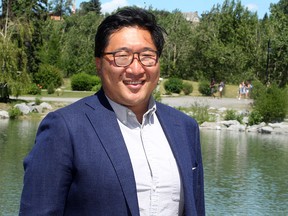Alberta Health Services awaits advice before rolling out new COVID treatment
Author of the article: Dylan Short
Publishing date: Oct 21, 2022 •

A photo taken on February 8, 2022 shows a box of Evusheld, a drug for antibody therapy developed by pharmaceutical company AstraZeneca for the prevention of COVID-19 in immunocompromised patients at the AstraZeneca facility for biological medicines in Södertälje, south of Stockholm, Sweden.
PHOTO BY JONATHAN NACKSTRAND /AFP via Getty Images
Alberta Health Services is awaiting further guidance before deciding how to roll out a recently approved Health Canada treatment for COVID-19.
AHS spokesman Kerry Williamson said the provincial health authority is seeking direction from Canada’s Drug and Health Technology Agency before making any decision on the use of AstraZeneca’s Evusheld as a treatment option. He said that guidance is expected to be released before the end of the month,
“The specific details around timing and availability are being considered, and will be shared publicly in the near future,” Williamson said in an email.
Evusheld was approved on Tuesday by Health Canada as a treatment for mild to moderate cases of COVID-19. It had previously received approval to be used as a preventive measure for people unable to build up antibodies against the virus on their own.
Williamson said there is a healthy supply of Evusheld in the province and Alberta Health Services will work with federal counterparts whenever there is a gap to be addressed. He said approximately 1,581 doses of Evusheld have been administered in the province.
Dr. Jia Hu, a public health physician, welcomed the federal approval of Evusheld as a treatment, calling it another “tool in the tool kit” to fight COVID-19. However, he said immunizations through vaccines continue to be the best option to fight serious infections.

Alberta Health Services is awaiting further guidance before deciding how to roll out a recently approved Health Canada treatment for COVID-19.
AHS spokesman Kerry Williamson said the provincial health authority is seeking direction from Canada’s Drug and Health Technology Agency before making any decision on the use of AstraZeneca’s Evusheld as a treatment option. He said that guidance is expected to be released before the end of the month,
“The specific details around timing and availability are being considered, and will be shared publicly in the near future,” Williamson said in an email.
Evusheld was approved on Tuesday by Health Canada as a treatment for mild to moderate cases of COVID-19. It had previously received approval to be used as a preventive measure for people unable to build up antibodies against the virus on their own.
Williamson said there is a healthy supply of Evusheld in the province and Alberta Health Services will work with federal counterparts whenever there is a gap to be addressed. He said approximately 1,581 doses of Evusheld have been administered in the province.
Dr. Jia Hu, a public health physician, welcomed the federal approval of Evusheld as a treatment, calling it another “tool in the tool kit” to fight COVID-19. However, he said immunizations through vaccines continue to be the best option to fight serious infections.

Dr. Jia Hu, a public health expert, poses for a photo
in Prince’s Island Park. Saturday, June 26, 2021.
PHOTO BY BRENDAN MILLER /Postmedia file
He said it will take time for provinces to find the right way to make the treatment fit into the broader public health response, particularly as fewer people appear to be getting their latest booster shots.
“The more we have, the better, especially as people are less likely to be vaccinated, which remains the best thing for people to do,” said Hu.
Hu said until Evusheld is more widely distributed, the main form of treatment for mild cases is Pfizer’s Paxlovid; however, there are people that are unable to take that drug due to the way it interacts with other medications. He said Evusheld could help fill some of those treatment gaps.
The latest approval comes as the number of people in hospital with COVID-19 in Alberta is on the rise. The latest data from the province, provided earlier this week, shows there are 1,070 hospitalizations, including 33 people in the ICU. The hospitalization number is up from the 1,014 reported a week earlier.
A total of 32 people died during the past reporting week, bringing the total number of fatal cases in Alberta since the start of the pandemic to 4,983.
Meanwhile, wastewater tracking out of the University of Calgary shows that the rolling average levels of COVID-19 have risen slightly since the start of the month as Alberta enters into the fall respiratory illness season.
dshort@postmedia.com
He said it will take time for provinces to find the right way to make the treatment fit into the broader public health response, particularly as fewer people appear to be getting their latest booster shots.
“The more we have, the better, especially as people are less likely to be vaccinated, which remains the best thing for people to do,” said Hu.
Hu said until Evusheld is more widely distributed, the main form of treatment for mild cases is Pfizer’s Paxlovid; however, there are people that are unable to take that drug due to the way it interacts with other medications. He said Evusheld could help fill some of those treatment gaps.
The latest approval comes as the number of people in hospital with COVID-19 in Alberta is on the rise. The latest data from the province, provided earlier this week, shows there are 1,070 hospitalizations, including 33 people in the ICU. The hospitalization number is up from the 1,014 reported a week earlier.
A total of 32 people died during the past reporting week, bringing the total number of fatal cases in Alberta since the start of the pandemic to 4,983.
Meanwhile, wastewater tracking out of the University of Calgary shows that the rolling average levels of COVID-19 have risen slightly since the start of the month as Alberta enters into the fall respiratory illness season.
dshort@postmedia.com









